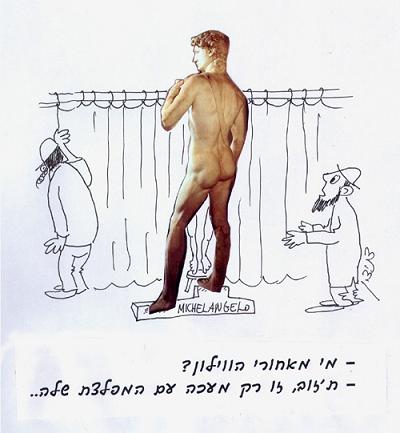
Tools which were formed for idolatry were forbidden for use and must be destroyed. Thus, for example, vessels decorated with drawings of the sun, the moon, or a dragon can be reasonably assumed to have been used for idolatry, so one who finds them must destroy them. How are these vessels to be destroyed? The sages disagreed. According to one sage they must be thrown into the Dead Sea, where no man can have the use of them. According to another sage, R’ Yossi, there is no need to throw them into the sea; it is enough to grind them into dust and scatter them to the winds. The sages argued against him, stating that if the vessels are scattered in the wind they may fall and fertilize ground crops and so people will benefit from vessels of idolatry. R’ Yossi tried to bring proof of his position from the Scriptures and the sages rejected his proofs: R’ Yossi told the sages that after the people of Israel created the Golden Calf Moses was forced to destroy it, and this is what he did: “Then I took the calf which you had made, and burned it with fire and crushed it and ground it very small, until it was as fine as dust; and I threw its dust into the brook that descended from the mountain” (Deuteronomy 9:21). This means that one must grind up the tools of idolatry and that there is no need to throw it in the sea; it is sufficient to throw it in the river or scatter it to the winds. (This translation is based on the interpretation by the authors of the Tosaphot.) The sages responded in their defense that Moses did not throw the Calf into the sea but had, instead to grind it and throw the dust into the river in order to examine the people by the drinking of the waters to see if they had taken part in the creation of the Golden Calf or not.
R’ Yossi continued to bring proof of his words. It is said of Maachah, mother of King Asa, that she sculpted a statue for idolatry and that Asa, as a loyal king, burned it and threw it into the river. “Also he removed Maachah his mother from being queen mother, because she had made an obscene image of Asherah. And Asa cut down her obscene image and burned it by the Kidron brook ” (I Kings 15:13). This shows that there is no need to throw it into the sea, that it is enough to throw it into a brook. The sages answered him: Nothing grows by the Kidron brook, so there is no question of its fertilizing crops. R’ Yossi answered them and said that other sages claimed there were crops in the area of the Kidron brook. The sages answered: There are places near the Kidron brook where things grow and places where nothing grows; Asa threw his mother’s statue in an area of the Kidron brook where nothing grows.
Incidentally the scholars clarified the exact nature of this statue made by Maachah. “What was her obscene image? Answer: Maachah built a statue with a male sexual organ and she would mount it each day.
R’ Yossi went on to bring proof of his words from King Chezkiyahu who ground up the copper snake which Moses had made, implying that it is sufficient to grind up vessels of idolatry and there is no need to throw them into the sea. The sages answered: The copper snake which Moses fashioned belonged to Moses, and other people are not forbidden to use a vessel which does not belong to them. During this discussion the scholars found a contradiction between what is written in Samuel and what is written in Chronicles: In Samuel it is written that David carried away the Philistine’s idols while in Chronicles it is written that David burned the idols. In Samuel it is written “And they left their images there, and David and his men carried them away” (II Samuel 5:21) and in Chronicles it is written “David gave a commandment, and they were burned with fire” (I Chronicles 14:12). The scholars reconciled the contradiction thusly: David at first planned to burn the Philistine’s idols, as written in Chronicles. Afterwards Ittai, a gentile resident of Gat, annulled the idolatry; after the idolatry was annulled they were permitted for use, and so David carried them away. The scholars went on to explain what is written in the Scriptures about the tools of idolatry which David carried away. It is related that David took the crown of the king of Rabbat Amon, which weighed a talent of gold, and put it on his head: “Its weight was a talent of gold, with precious stones. And it was set on David’s head” (II Samuel 12:30). The scholars asked how David could wear such a heavy crown on his head. Answer: The Scriptures do not mean that David wore the crown on his head, it means that the size of the crown matched the size of David’s head. A different scholar answered that there was a lodestone in the crown which helped David bear the weight of the crown on his head.
(Babylonian Talmud, Tractate Avodah Zarah 43b-44a)
